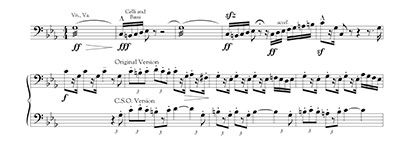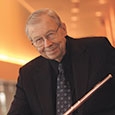I was an avid Spike Jones fan during my teenage years. I relished his no-holds-barred slapstick spoofing of the classics; especially the William Tell Overture (starring “Feedlebaum”), Poet and Peasant Overture, and Sabre Dance (check them out on YouTube). Fortunately I never outgrew my penchant for musical humor, and to this day I can still appreciate well-chosen comedic touches in music, whether by the composer or the performer.
Inspired by the long-running success in London of The Complete Works of Shakespeare (abridged) – 37 plays in 97 minutes! – I decided in 2004 to contribute to the musical humor genre by designing a potpourri of 33 flute audition excerpts titled The Compleat Audition tAngler (a piscatorial salute to Izaak Walton’s 1653 classic, The Compleat Angler) which I premiered on my 80th birthday “senior” recital at Northwestern in 2005. Charlie Geyer gave me a proper sendoff by playing the two trumpet calls from Beethoven’s Leonore No. 3 Overture, and then with Martin Amlin’s sensitive collaboration at the piano, we took off on the following 33 excerpts in 10 minutes: Leonore No. 3, Mozart D Major Concerto, Rossini William Tell Overture, Mozart G Major Concerto, Rimsky-Korsakov Russian Easter Overture, Stravinsky Petrouchka, Nielsen Concerto, Saint-Saëns Carnival of the Animals, Strauss Till Eulenspiegel and Don Quixote, Dvorák 8, Mendelssohn Scherzo, Hindemith Symphonic Metamorphosis, Strauss Ein Heldenleben, Dvorák 9, Bizet Carmen Intermezzo and L’Arlesienne Minuet, Ravel Daphnis & Chloe, Prokofiev Peter and the Wolf, J. Strauss Perpetuum Mobile, Beethoven 4, 7, and 3, Prokofiev Classical Symphony, Bach Polonaise and Badinerie from the B Minor Suite, Tchaikovsky 4, Shostakovich 5, Debussy Afternoon of a Faun, Schumann 1, and finally, the Ibert Concerto.
Truthfully, in order to shoehorn these 33 excerpts into a 10-minute medley I had to pare them down to an average of 18 seconds per excerpt, and then find the appropriate linking elements to make logical (but amusing) segues. For example, the 8-bar sustained pianissimo high D at the end of the Leonore No. 3 excerpt becomes the 4-bar high D that begins in the second bar of the solo entrance to the Mozart D Major Concerto. The half-note E-F# trill at the first big cadence of the Mozart (bar 46) resolves to the quarter-note D that becomes the lead-in to the staccato 32nds in the Andante section of William Tell. Four bars later the descending chromatic 32nds of William Tell lead into the low G that begins the second phrase of the Mozart G Major Concerto. And so on.
I performed the Compleat Audition tAngler again (this time with the added subtitle, 33 and 1/3 Expediently Excised Excerpts) at the 2008 NFA convention in Kansas City, expertly partnered by Robert Pherigo. (I also did it at the British Flute Society convention in Manchester a few weeks later with Richard Shaw.) On the Kansas City program I also introduced one of my more recent favorites for piccolo and piano, Jacques Castérède’s La Belle Époque. (There is a short section in the middle where the performer switches to flute.) The subtle humor in the Castérède is certainly a far cry from the antics of Spike Jones, but one can still appreciate the careful thought that the composer gave to introducing and developing the cameo appearances of Mozart’s Magic Flute (Papagena’s 5-note panpipes scale) and Rondo alla Turca, plus a snippet from the fourth movement of Beethoven 5. However, the first theme of the Haydn G Major Piano Trio (quoted in full) becomes the foundation of a series of variations based on the quadrille dance form. The signature opening turn figure of both the Haydn Trio and the Mozart Rondo alla Turca become the dominating intrusive elements heard throughout the piece. Although the technical challenges of La Belle Epoque are formidable for both piccolo and piano, they are well worth working out.
More recently, on June 7, I performed the Castérède with the ever-reliable Tim Carey at Nicole Esposito’s Iowa Piccolo Intensive and also on October 31 at the Rochester Flute Association’s Flute Fair with Minji Nam.
Some other compositions for piccolo that parody famous themes include the Lowell Liebermann Concerto (Mozart G Minor Symphony, Beethoven Eroica Symphony, and Sousa Stars and Stripes Forever). The Sousa march becomes the chief victim of Ken Laufer’s Scars and Scrapes Forever! (“A march into musical mayhem”) and also the last movement of the PDQ Bach Sonata Piccola, (S. 8va) (Edited to no small extent by Professor Peter Schickele).
With the availability of the fantastic resources of YouTube one can spend many delightful hours immersing oneself into the comedic world of music. Here are some of my favorites: Victor Borge, Spike Jones, Gerard Hoffnung (The Hoffnung Symphony), Rainer Hersch, Igudesman and Joo, PDQ Bach, Danny Kaye (Danny Kaye and the New York Philharmonic), Reggie Watts, Anna Russell, Florence Foster Jenkins, Jack Benny and Giselle MacKenzie, “What’s Opera, Doc?” (Bugs Bunny cartoon), and “A Night at the Opera” (the classic Marx Brothers film).
That last item reminds me of a book that I highly recommend, Sir Denis Forman’s A Night at the Opera: An Irreverent Guide to the Plots, the Singers, the Composers, the Recordings (Random House). Irreverent and funny it certainly is, but also full of reliable information and fascinating opera lore. I learned more about opera from this book than from any other. After reading about La Boheme, I laughed all the way to the Left Bank.
Victor Borge, topping the YouTube list above, also wrote a humorous book of biographies of famous composers, My Favorite Intermissions: Lives of the Musical Greats and Other Facts You Never Knew You Were Missing (Doubleday). He also wrote My Favorite Comedies in Music (Dorset Press). Victor Borge’s Comedy in Music, the longest running one-man show in the history of theater, opened on Broadway in 1953 and ran for 849 performances! He appeared with the Chicago Symphony several times as pianist and conductor, and I had the honor of playing principal flute in the last concert he conducted with the CSO in 1999 (he died in 2000). The concert included the Mendelssohn A Midsummer Night’s Dream Scherzo, conducted at the slowest tempo I have ever heard or played. It was breathtaking in the extreme.
Speaking of conductors, playing jokes on them can be a perilous business. Fortunately this was not the case with the affable James Levine who was famously duped in 1991 at a rehearsal of the Mahler 2nd Symphony at Ravinia, the summer home of the CSO. The first movement begins with the violins and violas executing a loud G tremolo that quickly diminishes. The cellos and basses then enter in the second bar with a fiercely dramatic triple forte explosion of sixteenth notes culminating four bars later into a dotted rhythm pattern.
Mahler Symphony No. 2, 1st Movement

Before the rehearsal, the CSO cellos and basses secretly conspired to piggyback onto that dotted rhythm theme as a perfect springboard into the Mexican Hat Dance. At bar 6, when they suddenly went “Mexican,” Levine and the rest of the orchestra, were taken by surprise and momentarily stunned before they burst into uproarious laughter and applause.
Luckily, WFMT was doing a sound check at the rehearsal and happened to record the celli-bassi escapade. That recording was broadcast with great jubilation at several subsequent CSO-WFMT Radiothons. Too bad that YouTube wasn’t around in those days to archive it. It would surely have gone viral!






